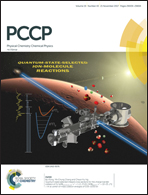Pressure induced topological phase transition in layered Bi2S3†
Abstract
A large bulk band gap and tunable Dirac carriers are desired for practical device applications of topological insulators. However, most known topological insulators are narrow gap materials and the manipulation of their Dirac surface states is limited by residual bulk charge carriers originating from intrinsic defects. In this study, via density functional theory based first-principles calculations, we predict that a layered hexagonal structure of Bi2S3 is stable, and it becomes a topological insulator under a moderate compressive pressure of about 5.3 GPa. Interestingly, we find that the strength of the spin–orbit interaction in Bi2S3 can be effectively enhanced by the applied pressure. This leads to an increased inverted band gap with pressure, which can reach 0.4 eV with a pressure of 13.7 GPa. Compared to Bi2Se3, intrinsic defects are suppressed in Bi2S3 under both cation- and anion-poor growth conditions. Our calculations predict a new Bi-based topological insulator, and also shed light on control over spin–orbit interactions in Bi2S3 and tuning of its topological properties.



 Please wait while we load your content...
Please wait while we load your content...